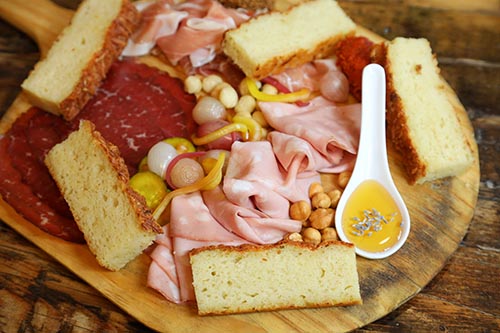There's a reason the charcuterie board is a time-honored tradition — and a dinner party favorite.
As the perfect centerpieces for parties, picnics and more, charcuterie boards are all the rage.
Traditionally served as an array of meats and cheeses, this dish is familiar to any modern foodie or chef. But what exactly is charcuterie, and more importantly: how do you make a charcuterie board?
Luckily, ICE New York Culinary Arts Chef-Instructor Chris Arturo is here to:
- Explain how to make a charcuterie board
- Drop some traditional and unique charcuterie board ideas
But first, a brief history lesson.
What is a Charcuterie Board?
Charcuterie (“char” for flesh + “cuit” for cooked) dates as far back as 15th century France. Salt-cured meats and organ pieces, often in the form of sausage, were sold in a charcuterie shop. This practice was rooted in the belief that no parts of the animal should go to waste.
Charcuterie 101
Now, charcuterie has evolved into an art form that comprises many different foods and styles. From Michelin-starred restaurants to picnics in the park, charcuterie boards are the centerpiece of any event or evening. It's a guaranteed crowd-pleaser.

How to Make a Charcuterie Board
Today's simple charcuterie board typically contains any combination of meats, cheeses, nuts, fruits, and crackers or bread. Regardless of what your personal preferences are, balance is key.
“I try to go for umami in all things,” Chef Chris says. “For me, I want fatty, sweet and vinegar-forward flavors in my board.”
Though Chef Chris builds his boards with vastly different items, meat must-haves include:
- Cured pork
- Cured beef
- Something ground and cured (like a soppressata)
- An emulsified item (like a mortadella)
Chef Chris’s favorites include jamón Serrano, mortadella and culatello. Then, he adds peppers and nuts for some non-meat options, rounding out the board with honey to balance out the salt and fat.
As for accoutrements, follow your heart.
“I don’t think there are any overrated accoutrements,” Chef Chris says.
If you’re looking for inspiration, though Chef Chris believes mostardas are "heavily underutilized.”
Other popular picks include olives, pickles, hummus, fresh fruit, and chocolate. (He'd also like to see more spice-forward pickled peppers.)
Charcuterie Board Ideas
Though traditional charcuterie boards are typically adorned with savory components, the board format is very flexible and can fit into most meals and lifestyles.
One idea is to create a dessert charcuterie board with fruit, marshmallows and homemade candy bars. Or, if you're hosting an adventurous crowd, you could try out the charcuterie board's ever-trendy cousin the butter board. Multi-course charcuterie-themed party, anyone?
Traditional charcuterie boards can also be easily adapted for vegetarians and vegans by replacing the meats with store-bought or homemade plant-based options. For an extra touch of fanciness, you could even age your own vegan cashew cheese.
At ICE, all Culinary Arts chef-instructors teach charcuterie boards as a part of the curriculum. Chef Chris' personal favorite topics are old-school terrines and pâté en croutes.
“Even if I started some of my cured meats on the first day, most likely students will have been out of school for a year or two by the time they’re done," he says "Therefore, I like teaching the methods of using scrap and underutilized/inexpensive cuts to make more cooked charcuterie.”
Learn all about charcuterie boards and more in ICE’s Culinary Arts program.




